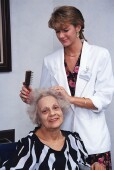
THURSDAY, Jan. 7 (HealthDay News) — Assisted living facilities for older people are most often located in areas with higher levels of income, education and home values, a new study shows.
These findings aren’t surprising because private dollars have fueled the growth of assisted living facilities, write the researchers. However, the findings do mean that people with lower incomes, minorities and those living in rural areas have fewer living options as they age.
“When we look at the distribution of the supply of assisted living facilities nationally, the assisted living facilities are distributed, in some respects, as you’d expect them to be,” said study author David Stevenson, an assistant professor of health policy at Harvard Medical School in Boston.
“These facilities tend to be located in higher socioeconomic areas — areas with more income, more education and fewer minorities,” he explained.
The results are published in the January issue of Health Affairs.
Assisted living is generally for people who don’t yet need the full-time care provided by a nursing home, but may need help with daily living. How this assistance is provided differs greatly from facility to facility.
“Assisted living varies tremendously,” explained Dr. Laurie Jacobs, director of the Resnick Gerontology Center at Montefiore Medical Center in New York City. “Nursing homes offer total care and don’t vary a lot, but assisted living can be apartments with a nurse available on the premises and communal dining [or] a facility that’s much closer to a nursing home setting.”
As the baby boomer generation continues to age, she said she expects that assisted living facilities will continue evolving and more creative options will likely emerge.
In 2007, there were 11,276 assisted living facilities with a total of 839,746 residential units in the United States, according to the study. Connecticut, Hawaii and West Virginia had fewer than 10 assisted living facilities per 1,000 elderly residents, while Minnesota, Oregon and Virginia had more than 40 facilities per 1,000 older Americans, according to the study.
Other findings:
- Household incomes were higher in areas with the highest penetration of assisted living facilities — $43,034 annually vs. $35,379 in areas with no assisted living.
- Average home values were $98,541 in areas with the most assisted living facilities compared to $69,560 in areas with no such facilities.
- College education rates were higher in areas with more assisted living facilities — almost 20 percent college-educated vs. 13.8 percent in areas without assisted living facilities.
- Areas without assisted living facilities were more likely to have a higher minority population — 17.1 percent compared to 12.8 percent in the areas with more assisted living facilities.
- Urban counties were more likely than rural counties to have assisted living facilities.
- In areas with assisted living facilities, more people have long-term care insurance and more nursing home patients pay their own fees.
These findings are most useful from a public policy perspective, Stevenson said. “We need to keep in mind that the assisted living supply isn’t distributed evenly, and that not all individuals would have access to assisted living even if public dollars were available to support it,” he said.
It’s also important to realize that assisted living isn’t always the right option, Jacobs said. For example, elderly people with dementia often can’t cope with the change to assisted living because they’ve lost the ability to learn new things, such as where food is kept or which drawer has the socks, she said. These people may be better off at home where they’ve lived for years, with a home health aide checking in on them.
“This is a very complicated issue,” Jacobs said. If you’re concerned about aging parents, she said that their doctors can let you know what their current needs are and anticipate what their future needs might be.
A social worker, if one is available to you, should know many of the options in your area, Jacobs said. But, she said, no matter what type of facility — nursing home, assisted living or something else — you’re thinking about, the most important thing is to look at the facility yourself and bring your parent with you to make sure it’s a good fit.
More information
Read more about assisted living from the National Institutes of Health.

